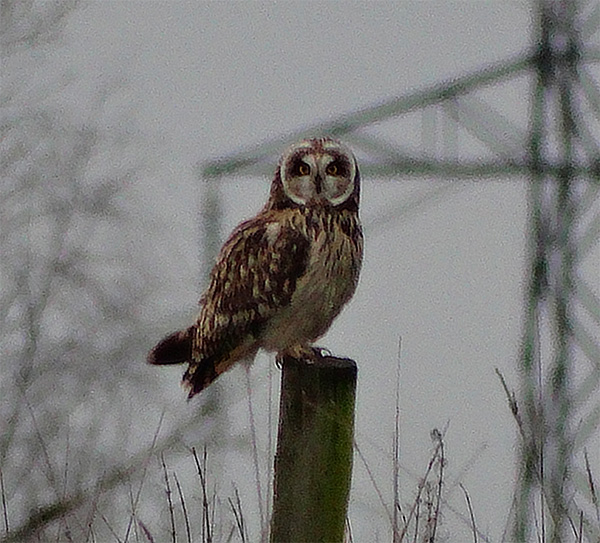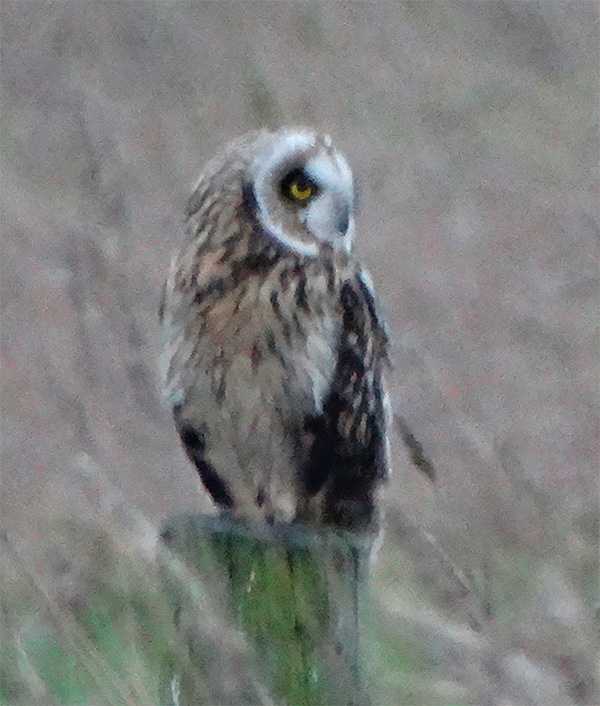Last winter the Ruislip Woods played host to as many as fifty of our largest finch, the Hawfinch. The birds stayed throughout the winter months and then departed from whence they came back to northern Europe to breed. No one saw them leave and it was perhaps no surprise that this once in a generation event did not re-occur this winter. Not one bird was seen anywhere in the woods in a return to the status quo.
It was therefore with great excitement that we were to be blessed with some more charismatic birds from places north and east with the arrival of three Short eared Owls which turned up just before Christmas. The birds stayed well into the New Year and were to be found in the large area of rough fields to the west of Bayhurst Wood. This is one of the diurnal (i.e. to be seen in daytime) species of owl and they can be expected to leave their daytime roosts in the late afternoon, hunting until dusk, which proved to be the case for these birds.

The open fields here, formerly a sand quarry and then a landfill site before being grassed over, also played host to three of these lovely birds two winters ago. It is unlikely that they are the same birds as this year but possibly so. To watch all three birds hunting in the late afternoon, dropping frequently into the long grass after voles etc. was a wonderful site and certainly not one that occurs very often in our area.
This picture and the one below, both show Short Eared Owls in the fields next to Bayhurst Woods.
Another species of owl has been frequenting the same area for a few months now. This is the ghostly Barn Owl. Also abroad in the late afternoon and in the evening, and again at dawn, this lovely bird is a fine addition to the local fauna. A pair were present and there is a possibility that they bred close by. Watching one of these birds out hunting in the failing light is one of nature’s wonders and the sight is enough to take one’s breath away.
A true diurnal species is the Little Owl. This species can be seen at all times of the day and can often be located by their strange single and repeated whistle call. They frequent isolated old trees on the edges of woods and in hedge lines and are recorded from the farmland bordering Bayhurst and Mad Bess Woods. The more public Copse and Park Wood do not have the right habitat for them, being as they are , surrounded by the urban fringe and a golf course.

We all know the Tawny Owl which also goes under the name of the Brown Owl. This is a bird of deep woodland and urban gardens and is truly nocturnal. Late February and early March is a good time to hear them as this is the time of year that they start looking to establish territories and become more vocal. This species is more often heard than seen but there is a way of seeing one in the daytime if you are very lucky and know what to look out for. If you hear a commotion of small birds whilst walking through the woods it could be that you are near a roosting Tawny Owl. Move gently towards the sound being very careful not to disturb the scene and, as you get close, you may spot the object of the small birds attention and it may be a roosting Tawny Owl. They can be very difficult to spot, especially in Ivy covered trees which they prefer, but you may be lucky and see one.
There has never been a record of the scarcest of the UK species of owl, the Long eared Owl, in the Ruisilp Woods and this is no surprise. The habitat is not right for them as they prefer coniferous woods and shelter belts in winter and summer and we shall probably never see one here, although one never knows.
As the winter comes to an end there may still be time to see the Short eared Owls before they depart back to the far north to breed. Even if you do not strike lucky you may hear a Tawny Owl or even a Little Owl on your walk. If you do spot an owl, any owl, then savour the moment as this chance does not come along very often.
John Edwards, Ruislip and District NHS.
